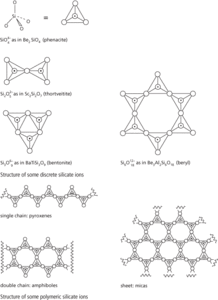A group of rock-forming minerals that make up the bulk of the earth’s outer crust (about 90%) and constitute one-third of all minerals. All silicate minerals are based on a fundamental structural unit – the SiO4 tetrahedron (see silicate). They consist of a metal (e.g. calcium, magnesium, aluminium) combined with silicon and oxygen. The silicate minerals are classified on a structural basis according to how the tetrahedra are linked together. The six groups are: nesosilicates (e.g. olivine and garnet); sorosilicates (e.g. hemimorphite); cyclosilicates (e.g. axinite, beryl, and tourmaline); inosilicates (e.g. amphiboles and pyroxenes); phyllosilicates (e.g. micas, clay minerals, and talc); and tektosilicates (e.g. feldspars and feldspathoids). Many silicate minerals are of economic importance. Pauling’s rules provide a useful guide for understanding the structures of silicates.

Silicate minerals
- thoracic vertebrae
- thorax
- Thoreau, Henry David (1817–62)
- thoria
- thorium
- thorium series
- thorium–lead dating
- thorn
- thorn apple
- Thornthwaite, Charles Warren (1889–1963)
- Thornthwaite climate classification
- Thornton, Kathryn Ryan Cordell (1952– )
- Thornton, William Edgar (1929– )
- Thor rocket
- thought experiment
- Thrace
- thrashing
- Thrasymachus (430–400)
- thread
- thread bump
- thread cell
- threaded list
- threading
- threat
- threat display